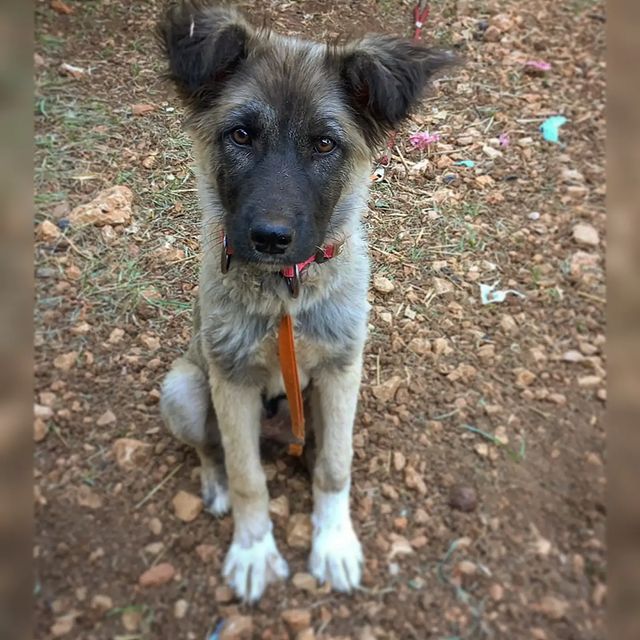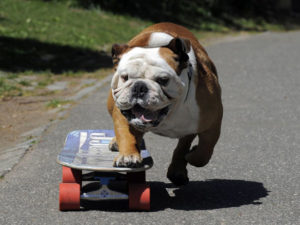All dogs should learn basic obedience, and sitting when told is a particularly useful skill for a dog to master. Sitting on command can be especially beneficial to your dog in greeting situations. In fact, with proper training, your dog can learn that sitting is the best way to encourage people to say hello. Teaching your dog to sit on command is relatively easy.

Step 1: Teach Your Dog to Sit on a Verbal Cue
- Stand up, say “Sit,” and then guide your dog into a sit with a treat placed right in front of her nose. To effectively guide your dog into a sit, follow these steps:
- Hold a treat between your thumb and fingers, clutching the treat as if you’re holding a pencil.
- Keep the treat within one inch of your dog’s nose. Don’t let your fingers and the treat get any farther away from her, or you might have trouble getting her to move her body into a sitting position. In fact, if your dog jumps up when you try to guide her into the sit, you’re probably holding your hand too far away from her nose. If your dog backs up, you can practice with a wall behind her so that she can’t back away from you.
- Guide your dog into the sit by moving the treat toward the top of her head, arching it up over her nose so that she has to raise her nose straight up to follow the treat. Most dogs will track the treat with their eyes and follow it with their noses, causing their snouts to point straight up. Usually, when a dog’s nose goes up, her rear will move down toward the floor. Voilà! You have a sitting dog.
- The instant your dog’s rump hits the floor, say “Yes!” and give her the treat in your hand.
- Encourage your dog to stand up again. Then repeat the steps above until your dog readily follows the food lure and plops into the sit position when you say “Sit.”
Step 2: Remove the Treat from Your Guiding Hand
Once your dog catches on and sits when you guide her with the treat, leave the treat in your pocket (or have it in your other hand). Repeat the same sequence as in Step 1, but this time your dog will just follow your empty hand.
- Say “Sit” and bring your empty hand in front of your dog’s nose, holding your fingers as if you had a treat. Move your hand exactly as you did when you held the treat.
- When your dog sits, say “Yes!” and then give her a treat from your other hand or your pocket.
Step 3: Fade Out the Hand Signal
Gradually lessen the amount of movement with your hand. First, say “sit.” Then hold your hand about 8 to 10 inches above your dog’s face and wait a moment. Most likely, she will sit. If she doesn’t, help her out a bit by moving your hand back over her head, as you did before, but make a smaller movement this time. Then try again. Once your dog responds to the word “Sit” and the sight of your hand a foot from her nose, begin holding your hand out with your palm up. Repeat the steps as before. Your goal is to eventually just say “Sit” without having to move or extend your hand at all.
At this stage, you can also put treats on a nearby table or countertop and, when your dog sits, say “Yes!” and deliver a treat from the table. This teaches your dog to wait for a second or two for her reward. She’ll also learn that once she’s heard you say “Yes,” she’ll still get a reward, even if she can’t see it. She’ll learn that it may come from anywhere! Without this step, some dogs become so reliant on seeing the treat that they won’t sit unless the treatment is clearly visible.
Step 4: Teach Sit to Greet
Once your dog reliably sits on cue, you can ask her to sit whenever you meet and talk to people. The key to this is anticipation. Give your dog the cue before she gets too excited to hear you and before she starts jumping up on the person she wants to greet. Generously reward your dog the instant she sits. Say “Yes” and give her treats every few seconds while she holds the sit. Use high-value treats, like chicken, cheese, ham, or hot dogs, diced into small pieces. Whenever possible, ask the person you’re greeting to help you out by turning and walking away if your dog gets up from the sit and lunges or jumps toward him or her. With many consistent repetitions of this exercise, your dog will learn that impolite lunging or jumping makes people go away, and polite sitting makes them stay and give her attention.
Final Tips
- If you’d like help teaching your dog to sit—or if you’d like to learn how to train additional useful skills—consider contacting a Certified Professional Dog Trainer (CPDT) in your area. Many CPDTs offer private lessons and group obedience classes that focus on fun, effective training methods.
References:
- https://www.wikihow.com/Train-Your-Shih-Tzu
- https://www.aspca.org/pet-care/



